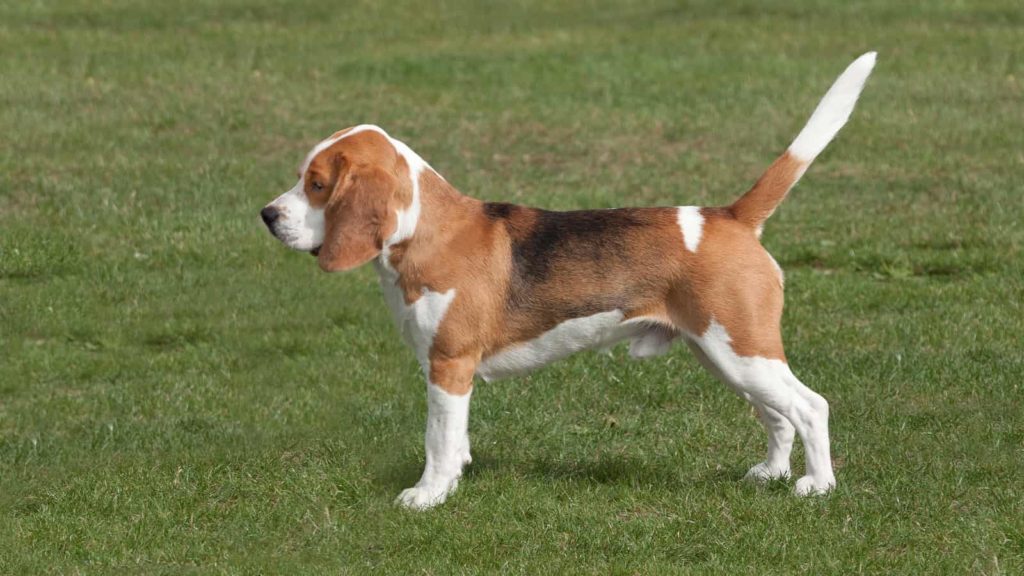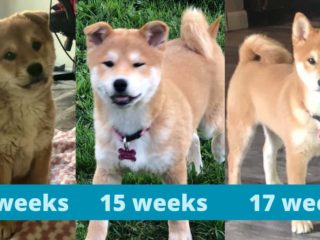Our dog’s tails can tell us a lot about what they are thinking and feeling. Even our dogs who have docked tails or natural bobtails can be expressive. Beagles have the full range of tail diversity and today we are going to discuss all aspects of their fluffy or stubby back ends!
This article is meant the be a complete guide to answer every question you might have about your Beagles tail and then some! Be sure to keep reading to the end so you can get a sneak peek at our most popular Beagle article that answers a very important question.
What does a Beagles Tail Look Like
A normal Beagles tail extends out from the spine in a straight line and angled upward from its back. Its thickest point is from the rear end of your Beagle and it should slowly taper to a point. The hair on its tail is long and sleek, but maybe a bit thicker than elsewhere on its body.

The AKC standard for a Beagles tail is:
“Set moderately high; carried gaily, but not turned forward over the back; with slight curve;
short as compared with size of the hound; with brush. Defects-A long tail. Teapot curve or
inclined forward from the root. Rat tail with absence of brush.”
The tail needs to be fairly high on the rump and carried in a lively fashion, but it should not curve over the back.
Pro Tip: If you are interested in the best grooming tools for your dog you can find them by clicking here now!
How long are Beagle’s tails?
A Beagles natural tail is on average are 8 to 13 inches long however it is not uncommon for Beagles to have tails ranging from 4 inches all the way to 14 inches long. The taller your Beagle is the longer its tail will be. Beagles who have docked tails will have tails ranging from 2 inches to 5 inches.
Disclaimer: This post may contain affiliate links. We only recommend high-quality products that are used and recommended by real owners. If you use these links to buy something we earn a small commission.
Do Beagle Have Curled Tails
Beagles generally do not have curly tails. Their tail can have a slight curve shape like a crescent, but going by high-quality breeding standards the tail should be held straight. If your Beagle has a very curly tail it could be the genetics of the parents or may mean it’s not purebred.

Genetics of the mother and father play a big role in how your Beagle’s tail will look. Some Beagles have a more curved tail because that is how the mother and father of your Beagle pup looked.
There is a higher chance that if your dog has a very curly tail that it could be mixed with another breed.
Some breeds that have curly tails that may be mixed with your Beagle are a Pomeranian, a Pug, or a Chow Chow.
If your Beagle has a curled tail it is not usually anything to worry about. An arch or curve to the tail is just fine for a Beagle that is a pet. If you are looking for a show dog however you will need to make sure you have a Beagle with a high set straight tail that follows the breed standards set by the AKC.
If your Beagle has a very curly tail, or a kink in its tail it could indicate a deeper problem.
As a Beagles tail is an extension of their spine the posture of your Beagles tail can give you some clues into your dog’s spine health.
If you notice that your dog is sitting with its back end slightly sideways and the tail looks to be off to one side it could mean that their spine is out of alignment and it would be best to get him an adjustment.
It would also be recommended that you don’t breed your Beagle as this flaw can be passed down to the puppies and become more problematic for each generation going forward.
Do Beagles get their tails docked?
Beagles generally do not have docked tails. The standard is to leave them long and natural. Even though Beagles are hound dogs they tend to carry their tail high enough to not cause injury or problems. Occasionally some Beagle owners do choose to dock their dog’s tail.
Keeping a long natural tail is common in part because the white tip on a Beagles tail is important to help its owner see them in long brush.
Being a scent hound a Beagle is often used for tracking. Hunters will use beagles to help them track small game.
When talking with some hunters who own Beagles a few of them have told me that they dock their Beagle’s tails because they have had experiences when hunting with their Beagles that their tails get injured and bleed from banking through the thick brush.
Working Beagles may have their tails docked for these reasons.
- Long tails get burs and stickers in them from being in the brush and fields often.
- Their tails are in danger of being stepped on by horses and other large animals.
- Their tails may easily get snagged in gaits fences or other things.
- They are overall more prone to injury which can cause the dog undue pain and may result in having to get its tail docked (amputated) as an adult which is much more painful to do than as a puppy.
The owners I mentioned before have done blood tests on their dogs and have found that their blood counts were too low because of the loss of blood from their injured tails. For this reason, they felt that docking the tails was imperative.
Owners who do choose to dock their Beagle’s tails should have their tails docked between 2-5 days old. If the dog is intended to be a working dog and used quite a bit for tracking and hunting docking them young will protect them in the long term.

Docking tails is a highly controversial subject. You will find dog owners who will argue for both sides. Most Beagle breeders will not dock their litters’ tails.
Docking is a tradition that dates back to Roman times where they would dock a dog’s tail because they believed it prevented rabies. In the United stated the practice of docking tails for cosmetic reasons began in the 1950s. This was done to conform to the breed standards and be accepted into the AKC.
Fun Fact: In the 18th century there was a tax imposed on all dogs unless they were working dogs. So naturally, people decided to cut all ‘Working dogs’ tails off to tell them apart from non-working dogs. And well, that led to owners cutting off their non-working dogs’ tails just to avoid getting taxed.
Can a Beagle Be Born With a Stub Tail?
Generally, Beagles are not born with a natural stub tail. A short tail most likely means it was docked as a newborn. However, a variant in the DNA of an important gene during development in the womb may result in a congenitally short (bobtail) or completely absent tail.
Some breeds like Australian Shepherds have been bred to favor this gene and are more likely than Beagles to favor a natural bobtail.
If your dog has a short tail and you don’t know if it has been docked or not the only way to know if your dog carries this gene or not is to do a DNA test.
Beagle Tail Wagging and Communication
Beagles wag their tails for many different reasons. It’s a big part of how they communicate with you. Wagging their tail doesn’t always mean they are happy. They could be conveying other emotions like nervousness or fear as well. The key to understanding their tail wags is to put it together with all the other contextual clues they are giving you. What are their ears doing, their eyes, how is their posture? Noticing these things as well will help you know why your Beagle is wagging its tail.
Here are some things your Beagle could be communicating to you with its tail.
- Calm and chill – Tail in the natural resting position. Sleeping or resting or casually walking around.
- Greeting or I love you – Usually, a big carefree wag, accompanied by eye contact, coming to you and jumping on you or trying to get your attention.
- Curious or unsure – Backwards and gentle wagging. Maybe sniffing around a little, intense and curious staring. Looking to you for reassurance.
- I’m nervous or scared – The tail between their legs and possibly slightly moving. Body tense, eyes down, ears laid back. Could also be trying to communicate a submissive position.
- Aggression – Tail high in the air and rigid. Poised, rigid, and making eye contact. Could be barking or growling as well.
- Happy and Excited – Fast carefree wagging. Wiggling body, happy facial expressions. Body not tense, possibly going in circles around the object causing excitement such as a treat or toy.
There’s also been a study done that shows the direction that your dog wags its tail can show positive or negative emotion. Wagging their tail towards the right side of their body can indicate more positive emotions such as relaxed, and happy. Wagging their tails on the left side of their body is a sign of more negative emotions such as nervousness or fear.
For most Beagles wagging their tails to communicate is a natural and normal thing for them to do. Occasionally you will find a Beagle that doesn’t wag its tail at all. Don’t worry, you are not alone.
If your Beagle doesn’t wag its tail it’s most likely just part of its personality or genes. It could also be that they have an extra curly or short tail that makes it more difficult for them to wag, but it could also indicate a medical problem and they should be seen by your vet to rule out any serious issues.
If your Beagle has recently stopped wagging its tail then there are some other things you should consider. If you have just moved, or they are new to your home this could just mean they are nervous and need some time to get acclimated to their new environment.
Some dogs are bigger tail-waggers than others. If your Beagle doesn’t wag its tail at all then you will have to learn to identify other body language cues to help you understand what they are trying to tell you.

Beagle Tail Problems and What to Do.
If your Beagle is temporarily holding its tail in the down position it’s most likely an indication of submission or fear, but if your Beagle is unable to hold its tail upright as it has in the past or seems to be in pain it could indicate one of the following; limber tail, Patellar Luxation, IVDD (Intervertebral disk disease), or swollen anal glands.
Here is a list of other things that Beagle owners have said cause tail issues in their dogs. We will go into more detail below.
- Swollen Anal Glands
- Bent or Broken Tail
- IVDD (Intervertebral disk disease)
- Patellar Luxation
- Tail Tip Necrosis
- Limber Tail (Swimmers Tail)
- Constipated
Swollen Anal Glands in a Beagle
If you notice your Beagle chasing its tail a lot more than usual, scooting its bum across the carpet, or biting/licking around the base of its tail it could be that its anal glands are blocked and swollen.
Sometimes the solution to your dog’s tail problem is as simple as getting your dog’s anal glands expressed. You can have your vet do it, or learn to do it yourself.
If you notice any blood, redness, or swelling around the anus you need to take your dog to the vet ASAP! Excessive itching, scratching and swelling can cause trauma to the area or increase the chances of infection.
Bent or Broken Tail in Beagles
Another reason your dog may have for holding its tail down, curled or tucked under between its legs is a bent or broken tail.
Signs of a broken or sprained tail
- Swelling
- Bend or kink in the tail
- Difficulty or pain moving the tail
- Wagging it to one side
- Holding it in an unusual position
If your dog seems to be in any pain or is licking or biting at its tail more than usual that can be an indication that something isn’t right.
Broken or strained tails are usually caused by a traumatic injury such as being stepped on or slammed in a door.
It can be extremely painful to your dog and needs to have immediate attention from a vet. Minor injuries will most likely heal with rest and immobility. More serious injuries may require surgery or amputation.
If your dog has always had a bend in its tail and it doesn’t seem to be in any pain then this is probably an indication that at some point in its past it may have broken or strained its tail.
Unfortunately, A lot of owners who have adopted rescues have seen this in their sweet Beagle.
IVDD in Beagles
Another somewhat serious problem that can cause tail discomfort in Beagles is a back issue known as IVDD. The technical term for this is Intervertebral disk disease (IVDD) it can also be described as a ruptured, slipped, bulging or herniated disk in your dog’s neck or back.
This type of back issue is fairly common in smaller dogs like Beagles. Quite a few owners that I talked with have had this issue with their dogs. Some have been able to help their dog feel better with resting and medication, some have had to get their Beagles operated on.
Here is a good resource to look at if you feel like this might be your Beagles problem.
Beagle Patellar Luxation
If your Beagle is constantly Holding his tail down or it seems to be in a down position more often than the normal resting position this could indicate a problem called Luxating Patella.
This really is just a fancy way to stay a misplaced knee cap. Besides the tail, another indication this may be the problem is if you notice your dog stretching out their rear limbs and walking in circles, or possible yelping or whining in pain.
Luxated Patella is a common problem for small breeds and often will self-correct after a few days or rest and stretching.
If it seems to be causing your dog a lot of pain or the problem is not going away it’s best to take your dog to the vet. They will assess the situation and if this is a recurring problem for your dog may recommend surgery to fix the problem. If surgery is performed it should be a permanent fix for your dog.
Beagle Tail Infection (Tail Tip Necrosis)
This is a very serious problem, but thankfully very rare in Beagles. It can be important though that you learn to identify it right away so the issue can be dealt with before it causes permanent damage.
This can be caused by the constant beating of the tail against objects that may harbor bacteria. If the tail gets an open wound and the bacteria gets in it can lead to an infection that will spread and cause the tissue to become damaged or start dying.
Watch for hair loss or baldness at the end of the tail. Excessive itching, bloody or brittle skin, foul-smelling, excessive biting or the tail.
Take your dog to the vet right away if you notice any of these things in your dog. The vet will assess and most likely have to amputate the infected part of the tail. This may be a very sad thing to have to deal with, but if the infection spreads it could endanger your dog’s life.
What is Limber (Swimmers) Tail In Beagle and What to Do
If you notice your Beagle tail hanging down and it looks limp and unnatural then he may have a condition known as Limber Tail.
Limber tail Also known as swimmer’s tail, frozen tail, dead tail, broken wag, or cold tail is a condition that causes your dog to hold his tail limp and down instead of the usual upright position. Its official name is Acute Caudal Myopathy.
It is most likely to happen after your dog has had very active or strenuous play, exercise, or excessive tail wagging. Sometimes a lot of swimming can cause it, being in cold wet weather, if they are confined to their crate too long, or if your dog’s tail is wagging and getting whacked on various surfaces.
This could cause your dog pain and swelling in their tail, making it difficult to sit. Usually, this condition will go away on its own after a few days of rest. It’s important to try and limit exercise and movement if you notice that your dog is experiencing this problem. If it is causing your dog a lot of pain then consulting your vet is a good idea.
Usually, this isn’t a chronic problem, but it is a good idea to figure out what may have triggered it in the first place and try to avoid that activity if possible. Coldwater play, or being confined in a crate too long are often things that could trigger this condition.

Beagle Chasing its Tail or Biting its Tail
For the most part, if your Beagle is chasing its tail it’s most likely just a harmless and adorable game. Puppies tend to do this a lot because they are so playful and exploring more about their world while discovering their fun long tails. If your dog is chasing his tail it might be because he’s bored or it’s just a fun game for him.
The problem comes when your dog is obsessively chasing its tail and it seems like they are in pain stressed or licking and biting its tail that causing things like bleeding, or hair loss.
If this is the case then rightfully you are probably concerned.
The cause for this could be one of several things. Here are the things that you can look for.
- Impacted anal glands.
- Parasites like fleas or ticks in the tail.
- Injury or sharp pain somewhere on the tail.
- Allergies or itchy skin.



